|
Lilian J. Rice’s Journey Through Spain
The Untold Inspiration Behind Rancho Santa Fe
By Diane Y. Welch
May/June 2025
Editor’s note: Diane Y. Welch is Lilian J. Rice’s official biographer, as designated by Miriam Wallace Sellgren, a Rice descendant, and an award-winning author, journalist, and local historian.
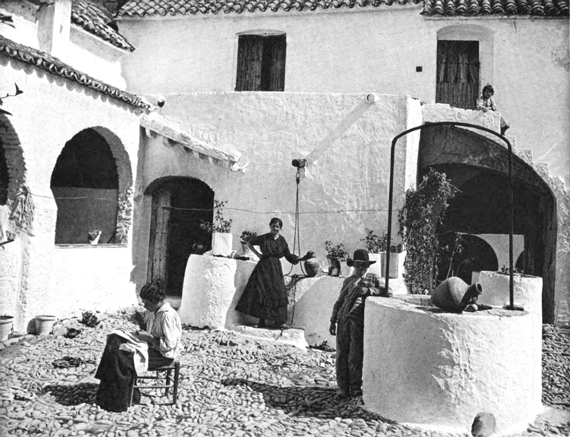 People using a courtyard in Tarifa, c. 1920 |
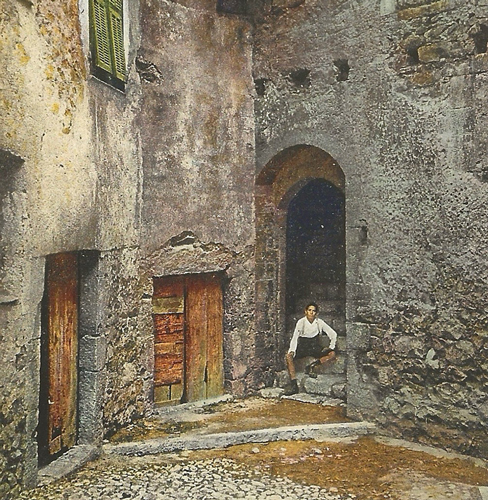 Local working-class homes in La Turbie, Southern France, reflect the region's traditional stone construction, shown on a c. 1920 postcard |
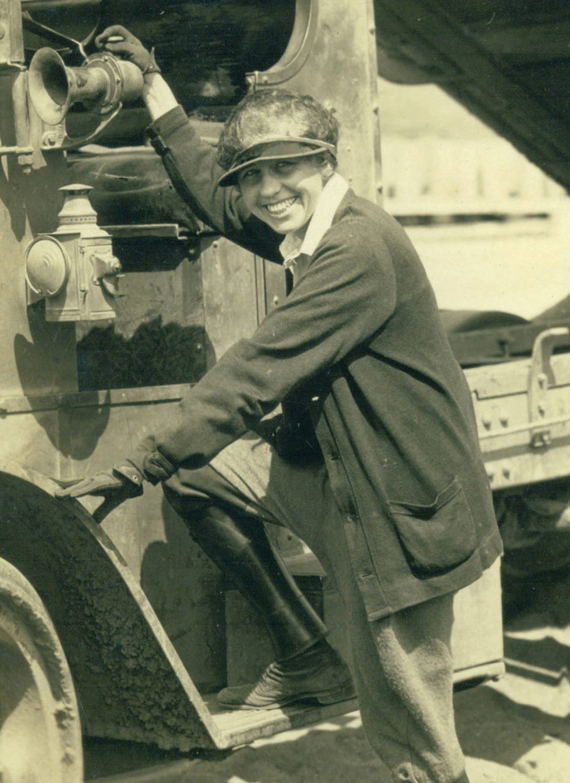 Lilian J. Rice at work in 1923 |
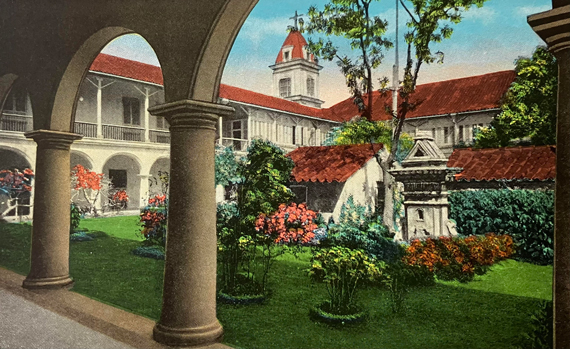 Postcard view of Santa Clara Convent, Havana, Cuba c. 1920 |
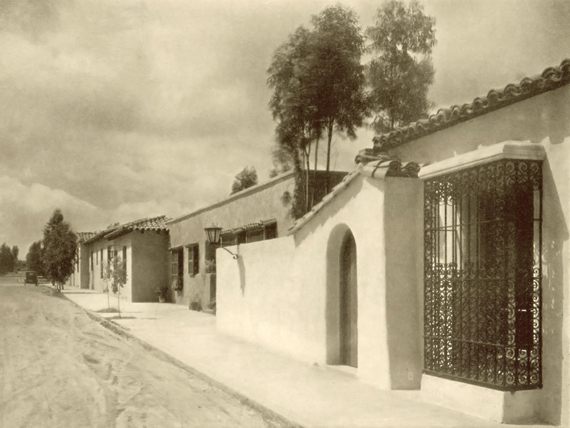 This photo of the four row houses that Rice designed in Rancho Santa Fe appeared in a 1927 promotional booklet for the master-planned community with the caption, “Remind one of a village in Spain.” All are still occupied homes, and two of the four are on the National Register of Historic Places. |
Architect Lilian J. Rice, while known mostly for her work in Rancho Santa Fe, also designed many buildings countywide and even one in Connecticut. Recognized for attention to site and local context, Rice is now a nationally acclaimed architect lauded with 13 buildings on the National Register of Historic Places. Born in National City in 1889, she obtained a degree in architecture from the University of California in 1910. She was inducted into the local chapter of the American Institute of Architects in 1931.
Despite claims that Rice never toured Spain to gather design inspiration, historical documents tell a different story. As this year marks the centennial of her 1925 travels, it’s timely and important to set the record straight.
While Rice was working at the San Diego firm of Requa & Jackson, she toured Spain—the year before architect Richard Requa's first trip there, in 1926. He published his architectural travel photographs and drawings in books that are still available. Rice's trip images and insights appeared in a Rancho Santa Fe newspaper; she also gave lectures about her trip to local women’s clubs.
While ship manifests are unavailable, the inbound details inform us that Rice, at age 36, was indeed in Europe a century ago. According to the ship’s manifest dated November 21, 1925, Rice sailed on the S.S. Aquitania, which departed from Cherbourg, France and arrived in New York six days later.
Prior to her European tour, Rice also journeyed to Cuba. Again, outbound trip records are unavailable, but the inbound trip is documented on the S.S. Governor Cobb’s manifest. She sailed from Havana on April 15, 1925, and arrived in Key West, Florida later that same day.
Both trips would have involved a long train ride across the U.S. on the Atchison, Topeka, and Santa Fe Railway, and it is likely that the Santa Fe Land Improvement Company—the railroad’s affiliate and Rice's client for the new master-planned community of Rancho Santa Fe—sponsored her travel.
Exploring Europe, Rice took hundreds of photographs and made many sketches. At Spain's southernmost tip, she captured the architecture of Tarifa and its authentic blend of Moorish and Andalusian influences: whitewashed buildings, arched colonnades, narrow cobbled streets, and simple cubic houses.
Tarifa’s blend of architectural simplicity and function would be mirrored later in the principles she expressed in her own designs. Pairing Native American Pueblo elements with a formal Spanish style, her homes featured unique geometric massing, rough stucco with rounded corners, varied red-tiled rooflines, deep-set windows with wooden balconies, and wrought iron details.
Postcards Rice collected that her family saved provide a pictorial record of the places she visited during her European trip. In Spain, she journeyed to Sevilla, Toledo, Tarifa, and Granada, visiting palaces and urban dwellings. She also toured Italy, France, and North Africa.
Back home in California, Rice put to use design principles she observed in Toledo and Tarifa when she created four row houses in Rancho Santa Fe’s Civic Center. Completed in 1926, this row was constructed as a contiguous whole with facades extending to the sidewalk and embodying the Spanish tradition of inward-facing homes with private inner courtyards.
Because Rice was highly social, her travels were of interest to the local press, and published accounts provide the facts of her overseas tours.
A brief item appeared in the National City News on September 18, 1925: “Miss Lillian (sic) Rice, daughter of Mr. and Mrs. J. A. Rice of E. Second Street…is planning to sail from New York on the 16th of September for an extended three months trip to Europe.” A second notice, published in the same paper on December 25, 1925 tells of Rice’s homecoming, noting: “[she] has recently returned from a three months tour abroad, where she reports having had a most delightful sojourn.”
Later, Rice published some of her architectural photographs in the Rancho Santa Fe Progress newspaper, including the Santa Clara Convent in Havana, and from Spain, a street in Tarifa, and the Generalife Gardens in Granada.
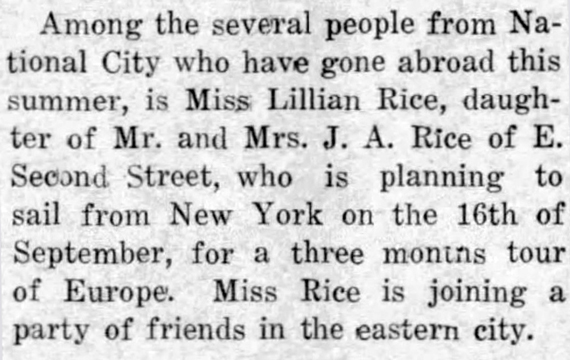 |
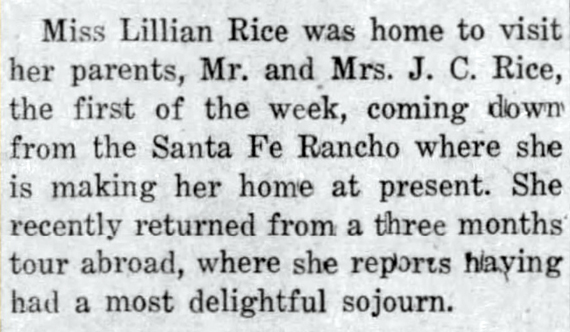 |
Two National City News items document that Rice was in Europe in 1925. All photos and images courtesy the author's Lilian J. Rice collection |
“Beginning always with a provision for practicality and achieving a true artistry, the charm of Spanish architecture has endured and will endure. Its underlying motive is honesty—honesty in plan, in materials, and a sincere attempt to meet the requirements imposed by the environment,” Rice wrote in 1928.
With official and personal records confirming her journeys in 1925, any doubts about Rice’s travels are now put to rest. Rice’s Cuban and European experiences undeniably shaped her influential architectural legacy. Let’s celebrate this important architect in an anniversary year when travel enhanced her authentic mark on San Diego.
BACK to table of contents
|
2025
2024
2023
2022
2021
2020
2019
2018
2017
2016
2015
|










